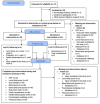Brief Exercise at Work (BE@Work): A Mixed-Methods Pilot Trial of a Workplace High-Intensity Interval Training Intervention
- PMID: 34278300
- PMCID: PMC8282817
- DOI: 10.3389/fspor.2021.699608
Brief Exercise at Work (BE@Work): A Mixed-Methods Pilot Trial of a Workplace High-Intensity Interval Training Intervention
Abstract
Introduction: The efficacy of high-intensity interval training (HIIT) for improving markers of physical fitness and cardiometabolic health is promising. The workplace is one non-laboratory setting where the effectiveness of HIIT could be explored. The aim of this study was to undertake a mixed-methods exploratory pilot trial of a workplace HIIT intervention named Brief Exercise at Work (BE@Work). Methods: Fifty-four healthy employees (mean ± standard deviation [SD] age 46 ± 10 years) from two workplaces in Northeast England were allocated to 8 weeks of thrice-weekly workplace HIIT based on boxing, stair climbing and stepping, comprising 4-7 60 s high-intensity intervals interspersed with 75 s rest (n = 30), or a no-intervention control (n = 24). The primary outcome was the change SD of predicted maximal oxygen consumption (VO2max). Markers of physical fitness, cardiometabolic health and mental well-being were also measured at baseline and follow-up. Participant perceptions of the intervention were explored in post-intervention focus groups (n = 9). Results: Mean (±SD) session attendance was 82% (±15%). Mean peak heart rate across the intervention was 87% of age-predicted maximal heart rate with a within- and between-subject SD of 5.5% and 3.7%, respectively. The SD of changes in predicted VO2max was 6.6 mL·kg-1·min-1 across both groups, which can be used to inform sample size estimations for a future full trial. The control-adjusted mean increase (95% confidence interval) in predicted VO2max was 3.9 (-0.2 to 8.1) mL·kg-1·min-1, corresponding to a Cohen's D of 0.47. We also observed preliminary evidence of small to moderate effects in favour of the intervention group for non-dominant leg extensor muscle power, markers of health-related quality of life, well-being and perceived stress and small to moderate effects in favour of the controls in perceived pain, physical activity and high-density lipoprotein cholesterol. During HIIT, focus group participants reported physiological responses they perceived as unpleasant or tiring (e.g., breathlessness, local muscular fatigue), but also that they felt alert and energised afterwards. Conclusion: The findings of this exploratory pilot trial support the implementation of a definitive randomised controlled trial to quantify the effectiveness of a workplace HIIT intervention.
Keywords: high-intensity interval training; intervention; mixed method; pilot trial; workplace.
Copyright © 2021 Burn, Weston, Atkinson, Graham and Weston.
Conflict of interest statement
The authors declare that the research was conducted in the absence of any commercial or financial relationships that could be construed as a potential conflict of interest.
Figures
Similar articles
-
Integrating high-intensity interval training into the workplace: The Work-HIIT pilot RCT.Scand J Med Sci Sports. 2020 Dec;30(12):2445-2455. doi: 10.1111/sms.13811. Epub 2020 Sep 11. Scand J Med Sci Sports. 2020. PMID: 32854153 Clinical Trial.
-
High-intensity interval training and moderate-intensity continuous training in adults with Crohn's disease: a pilot randomised controlled trial.BMC Gastroenterol. 2019 Jan 29;19(1):19. doi: 10.1186/s12876-019-0936-x. BMC Gastroenterol. 2019. PMID: 30696423 Free PMC article. Clinical Trial.
-
Effects of volume-matched once-weekly and thrice-weekly high-intensity interval training (HIIT) on body adiposity in adults with central obesity: Study protocol for a randomized controlled trial.J Exerc Sci Fit. 2024 Oct;22(4):329-340. doi: 10.1016/j.jesf.2024.05.001. Epub 2024 Jun 14. J Exerc Sci Fit. 2024. PMID: 38993983 Free PMC article.
-
Effects of different protocols of high intensity interval training for VO2max improvements in adults: A meta-analysis of randomised controlled trials.J Sci Med Sport. 2019 Aug;22(8):941-947. doi: 10.1016/j.jsams.2019.01.013. Epub 2019 Jan 29. J Sci Med Sport. 2019. PMID: 30733142
-
Effects of Workplace-Based Physical Activity Interventions on Cardiorespiratory Fitness: A Systematic Review and Meta-Analysis of Controlled Trials.Sports Med. 2019 Aug;49(8):1255-1274. doi: 10.1007/s40279-019-01125-6. Sports Med. 2019. PMID: 31115827
Cited by
-
Supramaximal high-intensity interval training for older adults in a community setting: a pragmatic feasibility study.Eur Rev Aging Phys Act. 2025 Jul 28;22(1):13. doi: 10.1186/s11556-025-00379-6. Eur Rev Aging Phys Act. 2025. PMID: 40721737 Free PMC article.
-
The MedXFit-study - CrossFit as a workplace health intervention: a one-year, prospective, controlled, longitudinal, intervention study.Front Public Health. 2024 Feb 21;12:1304721. doi: 10.3389/fpubh.2024.1304721. eCollection 2024. Front Public Health. 2024. PMID: 38450146 Free PMC article. Clinical Trial.
-
Mechanisms of the impact of exercise intervention on college students' mental health: a longitudinal experimental study using swimming as an example.Front Psychol. 2025 Jun 16;16:1535214. doi: 10.3389/fpsyg.2025.1535214. eCollection 2025. Front Psychol. 2025. PMID: 40589885 Free PMC article.
-
"I just had the feeling that the interval training is more beneficial": young adults' subjective experiences of physical fitness and the role of training modes.Front Sports Act Living. 2023 May 15;5:1115944. doi: 10.3389/fspor.2023.1115944. eCollection 2023. Front Sports Act Living. 2023. PMID: 37255731 Free PMC article.
-
Process Evaluation of Project FFAB (Fun Fast Activity Blasts): A Multi-Activity School-Based High-Intensity Interval Training Intervention.Front Sports Act Living. 2021 Sep 20;3:737900. doi: 10.3389/fspor.2021.737900. eCollection 2021. Front Sports Act Living. 2021. PMID: 34617011 Free PMC article.
References
-
- Beets M. W., Weaver R. G., Ioannidis J. P. A., Geraci M., Brazendale K., Decker L., et al. . (2020). Identification and evaluation of risk of generalizability biases in pilot versus efficacy/effectiveness trials: a systematic review and meta-analysis. Int. J. Behav. Nutr. Phys. Act. 17:19. 10.1186/s12966-020-0918-y - DOI - PMC - PubMed
LinkOut - more resources
Full Text Sources
Miscellaneous


